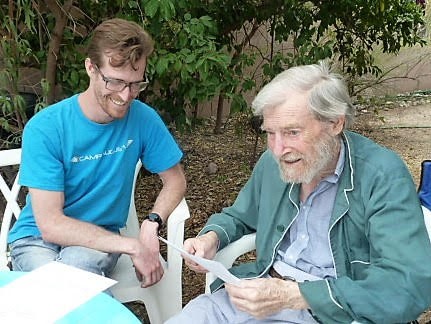Devin Bayly, University of Arizona research computing specialist, and his grandfather Maurice Bayly published their work on “Pairing of stimuli yields affect, positive mood and day-long motivation.”
Devin Bayly explained their research with an example where he said, “consider two rhyming words like champagne and membrane, or any two you like: a small pleasure is felt when the second word is heard forming a rhyming link with the first. These two inputs to the brain generate an output so there must be a system of neurons to make the link.”
Their idea is that this link is supported by a biological mechanism. Devin Bayly explained that how this link is accomplished is unknown and largely uninvestigated.
“My grandfather and I argue that this system of neuron activity is present as a backdrop to most if not all essential human behavior,” Devin Bayly stated.
Maurice Bayly came up with the idea while teaching a group of students in a geology course. He wanted to teach his students to be lifelong learners, but in order to accomplish that he would have to provide an enjoyable experience for his students. He explained that he then started to explore the subject of what is at the root of these joyful moments both in and outside of learning.
Maurice Bayly said he started his research by thinking about questions such as, why do we get pleasure from thinking? He explained that he was shocked when he realized that there was no answer and that these types of questions have been ignored.
“I’d like to explore the connections between our [pairing-induced positive affect] and the baseline level of motivation that allows each of us to get out of bed in the morning. I believe our ability to treat chronic mental health issues like depression may expand significantly with a greater understanding of the PIPA system,” Maurice Bayly stated.
“My greatest challenge has been motivating established researchers to chart the waters of an addition to the foundations of our understanding of human behavior,” Maurice Bayly stated.
RELATED: What have we learned about the coronavirus in the past 15 months?
Devin Bayly added, “the last century has paid little attention to positive effect from pairing, but perhaps the same won’t be said of the century to come.”
Their publication discusses the two-in/one-out system, which is when an item enters the active cognitive workspace matches up with an item present in the system. This puts out an effective response that activates reward. They also discuss pairing, which signifies a mental process when two items are brought together in the focus of attention.
“The more the items have in common, the more valid the pairing. At a neutral level, each of the items paired is firing pattern in a high-level network that represents a concept in the mind, but the neural activity may be prompted by objects, actions or events in the external world as well as by internal items such as memories,” the publication stated.
They also explained the outputs of the PIPA system, which is that specific pairings have clear pleasure associations and broader pairing provide a positive micro-affect. They also discussed mood and how most individuals are not constantly aware of their mood. They suggest that this means the state is not occupied by either the positive or negative end of the mood spectrum.
“Firstly, attention usually is focused on something more urgent, with this PIPA-driven mood overlaid and present only as background. Secondly, consider the air we breathe: it is essential to life but is so constantly present that it gets little attention,” the publication stated.
Lastly, they touched on motivation and they used two examples that show the smallness of the effects at PIPAs lowest level of motivation. The examples were housekeeping and conversation.
Maurice Bayly shared his favorite memory which was when a friend of his offered to read a brief section of his book “Our Joyful Minds.”
“She put the papers down before continuing and said with surprise, ‘This is huge, you realize that, right? This would turn the whole world of psychology on its head.’ That was the most gratifying moment of the last 30 years I’ve spent working on my ideas,” Maurice Bayly said.
Follow Jillian Bartsch on Twitter









